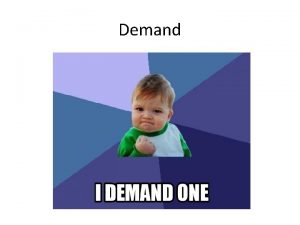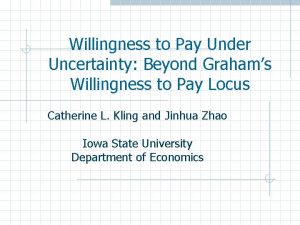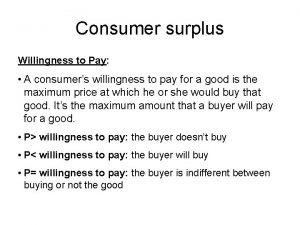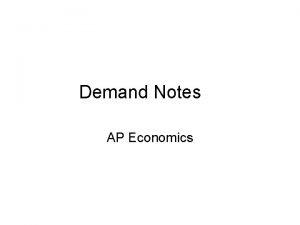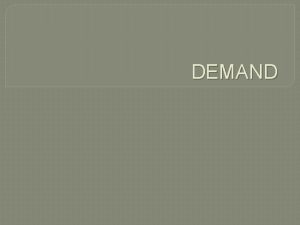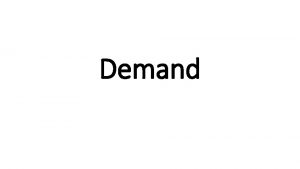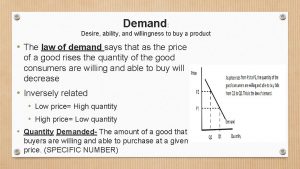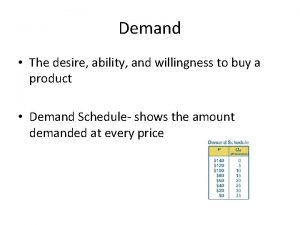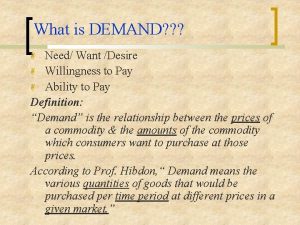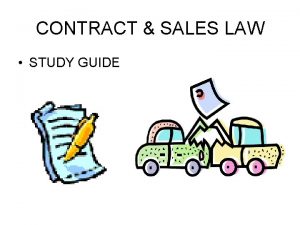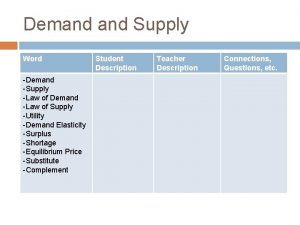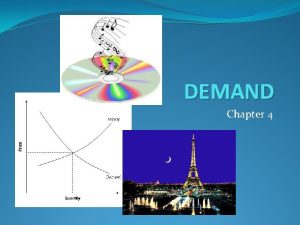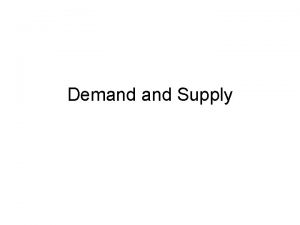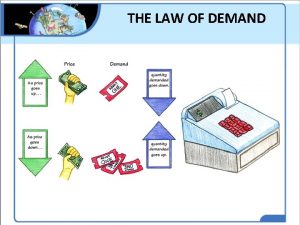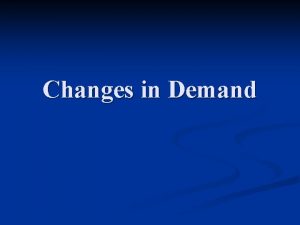Demand Law of Demand Demand the willingness and




















































- Slides: 52

Demand Law of Demand • Demand – the willingness and ability of buyers to buy different quantities of a good at different prices. • Law of demand – the price and the quantity demanded of a good are inversely related.

Substitution effect • The primary reason for the inverse relationship between price and quantity demanded is the substitution effect. • Substitution effect – a consumer will substitute lower-priced goods for higherpriced goods. • See Example 1 A on page 3 -1.

Income effect • The secondary reason for the inverse relationship between price and quantity demanded is the income effect. • Income effect – when the price of a good decreases, the consumer’s income has greater buying power, allowing the consumer to buy a greater quantity of the good. • See Example 1 B on page 3 -1.

Market for Good X Demand Schedule Price $7 Quantity Demanded 0 6 5 5 10 4 15 3 20 2 25 1 30

Demand Curve for Good X

Determinants of demand: • 1. Income. • a. For normal goods, income and demand are directly related. • b. For inferior goods, income and demand are inversely related. • See Example 3 on page 3 -3.

Determinants of demand: • 2. Preferences. • If consumer preference for a good increases, the demand for the good increases. • If consumer preference for a good decreases, the demand for the good decreases. • See Examples 4 A and 4 B on page 3 -3.

Determinants of demand: • 3. Prices of related goods (substitutes or complements). • The demand for a good is directly related to the price of a substitute. • The demand for a good is inversely related to the price of a complement. • See Examples 5 A and 5 B on page 3 -3.

Determinants of demand: • 4. Number of buyers. • An increase in the number of buyers for a good will increase the demand for the good. • A decrease in the number of buyers will decrease the demand. • See Example 6 on page 3 -3.

Determinants of demand: • 5. Expectations of future price. • If buyers expect the price of a good to rise in the future, the demand for the good now will increase. • If buyers expect the price to fall in the future, the demand for the good now will decrease. • See Examples 7 A and 7 B on page 3 -3.

Change in Demand • A change in demand refers to a shift in the demand curve. • A change in demand is caused by a change in one of the determinants of demand.

Change in Quantity Demanded • A change in quantity demanded refers to a movement along the demand curve. • A change in quantity demanded is caused by a change in price.

Supply and Law of Supply • Supply – the willingness and ability of sellers to sell different quantities of a good at different prices. • Law of supply – the price and the quantity supplied of a good are directly related.

Law of Supply • The seller’s goal is profit-maximization. • The higher the selling price, the easier it will be for sellers to cover their cost of production, and thus the greater the quantity supplied. • See Example 8 on page 3 -4.

Market for Good X Supply Schedule Price $1 Quantity Supplied 0 2 5 3 10 4 15 5 20 6 25 7 30

Supply Curve for Good X

Determinant of supply • The determinant of supply is the cost of production. • An increase in the cost of production will cause a decrease in supply (supply curve shifts to the left). • A decrease in the cost of production will cause an increase in supply (supply curve shifts to the right). • See Example 10 on page 3 -5.

Cost of Production • The cost of producing a good can be changed by a number of common factors, including; • 1. The prices of labor and other inputs. • 2. Technology. • 3. Taxes.

Change in Supply • A change in supply refers to a shift in the supply curve. • A change in supply is caused by a change in the cost of production.

Change in Quantity Supplied • A change in quantity supplied refers to a movement along the supply curve. • A change in quantity supplied is caused by a change in price.

Equilibrium • In a free market (a market in which price is free to adjust), the market price will be the equilibrium price. • The equilibrium price is the price where quantity demanded equals quantity supplied.

Equilibrium for Good X

Surplus • A price above equilibrium will result in a surplus. • Competition among the sellers to rid themselves of this surplus will drive the price down until the surplus is eliminated, at the equilibrium price.

Surplus

Shortage • A price below equilibrium will result in a shortage. • Competition among the buyers will drive the price up until the shortage is eliminated, at the equilibrium price.

Shortage

Free Markets and Efficiency • A free market is economically efficient because it produces the quantity of output: • 1. where marginal benefit equals marginal cost. • 2. that maximizes the sum of consumer’s and producer’s surplus.

Consumer’s and Producer’s Surplus

A Change in Equilibrium • Equilibrium price and quantity are determined by demand supply. • A change in demand or supply will result in a new equilibrium price and quantity.

Change Price Quantity • Demand increases Increases

Market Equilibrium

An Increase in Demand

Change Price Quantity • Demand increases Increases • Demand decreases Decreases

Market Equilibrium

A Decrease in Demand

Change Price Quantity • Demand increases Increases • Demand decreases Decreases • Supply increases Decreases Increases

Market Equilibrium

An Increase in Supply

Change Price Quantity • Demand increases Increases • Demand decreases Decreases • Supply increases Decreases Increases • Supply decreases Increases Decreases

Market Equilibrium

A Decrease in Supply

A Price Ceiling • Price ceiling – a maximum legal price. Creates a shortage and leads to: • 1. Fewer exchanges than at equilibrium. • 2. The use of nonprice rationing devices. • 3. Illegal transactions at prices above the ceiling.

Market Equilibrium

A Price Ceiling

A Price Floor • Price floor – a minimum legal price. Creates a surplus and fewer exchanges than at equilibrium. • To maintain a floor price, the government may step in and purchase surplus goods.

Market Equilibrium

A Price Floor

Price Controls and Inefficiency • A price control is economically inefficient because: • 1. A price control eliminates exchanges that would generate more marginal benefit than marginal cost. • 2. A price control eliminates exchanges that would generate additional consumer’s surplus and producer’s surplus.

Consumer’s and Producer’s Surplus

Deadweight Loss of a Price Floor

Markets Are Impersonal • Markets are impersonal in that the decisions of individuals are usually insignificant to the overall market. • Because markets are seen as impersonal forces, it is often politically popular for the government to “control” the market for the good of society.

Markets Are Personal • Markets reflect the personal choices of millions of individual consumers and producers. • When the government intervenes in the market, it is not just controlling some impersonal force; it is interfering with the personal choices of millions of consumers and producers.
 Newton's first law and second law and third law
Newton's first law and second law and third law Newton's first law
Newton's first law The willingness to exert high levels of effort
The willingness to exert high levels of effort Corporate governance introduction
Corporate governance introduction The willingness of one person or group to have faith.
The willingness of one person or group to have faith. Willingness to supply
Willingness to supply A speaker's willingness to take responsibility
A speaker's willingness to take responsibility Thank you to cooperating teacher
Thank you to cooperating teacher Tipp skills dbt
Tipp skills dbt Willingness to pay
Willingness to pay Boyles law
Boyles law How to calculate boyle's law
How to calculate boyle's law Module 5 supply and demand introduction and demand
Module 5 supply and demand introduction and demand Hát kết hợp bộ gõ cơ thể
Hát kết hợp bộ gõ cơ thể Slidetodoc
Slidetodoc Bổ thể
Bổ thể Tỉ lệ cơ thể trẻ em
Tỉ lệ cơ thể trẻ em Gấu đi như thế nào
Gấu đi như thế nào Chụp tư thế worms-breton
Chụp tư thế worms-breton Chúa yêu trần thế
Chúa yêu trần thế Các môn thể thao bắt đầu bằng từ đua
Các môn thể thao bắt đầu bằng từ đua Thế nào là hệ số cao nhất
Thế nào là hệ số cao nhất Các châu lục và đại dương trên thế giới
Các châu lục và đại dương trên thế giới Công thức tiính động năng
Công thức tiính động năng Trời xanh đây là của chúng ta thể thơ
Trời xanh đây là của chúng ta thể thơ Mật thư tọa độ 5x5
Mật thư tọa độ 5x5 Phép trừ bù
Phép trừ bù Phản ứng thế ankan
Phản ứng thế ankan Các châu lục và đại dương trên thế giới
Các châu lục và đại dương trên thế giới Thơ thất ngôn tứ tuyệt đường luật
Thơ thất ngôn tứ tuyệt đường luật Quá trình desamine hóa có thể tạo ra
Quá trình desamine hóa có thể tạo ra Một số thể thơ truyền thống
Một số thể thơ truyền thống Cái miệng bé xinh thế chỉ nói điều hay thôi
Cái miệng bé xinh thế chỉ nói điều hay thôi Vẽ hình chiếu vuông góc của vật thể sau
Vẽ hình chiếu vuông góc của vật thể sau Biện pháp chống mỏi cơ
Biện pháp chống mỏi cơ đặc điểm cơ thể của người tối cổ
đặc điểm cơ thể của người tối cổ V cc cc
V cc cc Vẽ hình chiếu đứng bằng cạnh của vật thể
Vẽ hình chiếu đứng bằng cạnh của vật thể Vẽ hình chiếu vuông góc của vật thể sau
Vẽ hình chiếu vuông góc của vật thể sau Thẻ vin
Thẻ vin đại từ thay thế
đại từ thay thế điện thế nghỉ
điện thế nghỉ Tư thế ngồi viết
Tư thế ngồi viết Diễn thế sinh thái là
Diễn thế sinh thái là Các loại đột biến cấu trúc nhiễm sắc thể
Các loại đột biến cấu trúc nhiễm sắc thể Số nguyên tố là gì
Số nguyên tố là gì Tư thế ngồi viết
Tư thế ngồi viết Lời thề hippocrates
Lời thề hippocrates Thiếu nhi thế giới liên hoan
Thiếu nhi thế giới liên hoan ưu thế lai là gì
ưu thế lai là gì Hổ sinh sản vào mùa nào
Hổ sinh sản vào mùa nào Sự nuôi và dạy con của hươu
Sự nuôi và dạy con của hươu Hệ hô hấp
Hệ hô hấp





















































